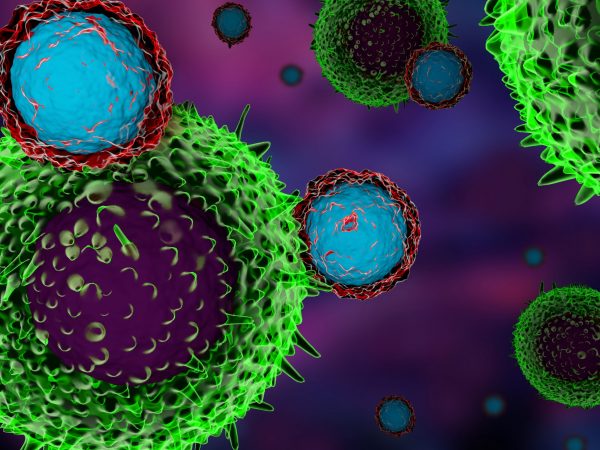Virtual Special Conference on Pancreatic Cancer: An Interview with the Conference Cochairs
Pancreatic cancer is notoriously challenging to treat, due largely to the fact that the disease is often diagnosed after the cancer has metastasized. As a result, the five-year relative survival rate is just 10 percent. It is estimated that roughly 47,000 people in the United States will die from pancreatic cancer this year.
Motivated by this difficult prognosis, substantial research in the pancreatic cancer field has resulted in a better understanding of the biological drivers of the disease, along with new treatment strategies.
To keep abreast of key advancements in the field, the AACR holds a special conference dedicated to pancreatic cancer each year. This special conference, which began in 2012 as a biennial series, transitioned to an annual conference last year. This year, the conference will be held virtually on September 29-30.
We had the opportunity to speak with the conference cochairs—AACR Past President Elizabeth M. Jaffee, MD, FAACR, from the Sidney Kimmel Comprehensive Cancer Center; Dafna Bar-Sagi, PhD, FAACR, from New York University Langone Medical Center; Brian Wolpin, MD, MPH, from the Dana-Farber Cancer Institute; and Ben Stanger, MD, PhD, from the Abramson Cancer Center of the University of Pennsylvania—about what to expect at the upcoming meeting.
The first AACR Special Conference on pancreatic cancer was held in 2012. What developments in the field have we seen in the last eight years?

MD, FAACR
Jaffee: As pancreatic cancer is typically diagnosed after the cancer has spread, it is important to find ways to identify patients who may have an increased risk of developing the disease. We have made progress in learning about risk factors, such as diabetes, that increase the incidence of pancreatic cancer.
Another key area of development has been advances in new models, such as transgenic mice and 3-D organoids, which have helped us to uncover biological pathways involved in pancreatic cancer development. Understanding these pathways has led to new drug development for this disease.
Bar-Sagi: We have learned quite a bit about the importance of tumor-host interactions for disease progression and response to therapy. In particular, we now have a much better understanding of the cellular composition of the tumor stroma, the role that the different cell types play in promoting tumor fitness, and the dynamics of the crosstalk between the tumor and the microenvironment. We also now have an improved capacity to manipulate this crosstalk due to the emergence of gene editing technologies as well as approaches for high-dimensional characterization of epithelial and stromal cells.

MD, MPH
Wolpin: From the clinical side, the chemotherapy regimens that we use for patients with metastatic disease have advanced during this time, and there are now two multi-agent chemotherapy programs that have become a staple in our treatment armamentarium. Additionally, genome-targeted therapies in pancreatic cancer have been approved in that time, such as olaparib (Lynparza) for patients with BRCA mutations and pembrolizumab (Keytruda) for patients with microsatellite-unstable tumors. In the systemic therapy realm, the treatments we use now are quite different compared with those we were using in 2012.
We are also doing better in curing patients who have localized disease. That is because of improvements across the board in surgery, radiation, and chemotherapy; each of these treatments has seen continued improvements, which have culminated in better survival rates. Further, because of the advances in chemotherapy and radiation, we can now offer more patients surgery than we did previously.
Stanger: Scientifically, the field has made great strides in our basic understanding of the unique metabolic, microenvironmental, and immunologic features of pancreatic tumors. Because an exuberant extracellular matrix and a paucity of blood vessels are hallmarks of the disease, pancreatic tumors have developed various ways to scavenge nutrients. We know a lot more about these scavenging mechanisms than we did a decade ago, which may turn into ideal targets for anticancer therapy.
There is also an increasing understanding of the complexity of the tumor microenvironment, which consists of a variety of different types of fibroblasts and immune cells. Pancreatic tumors mold their microenvironment in a way that protects them from immune attack. We have also learned a great deal about tumor heterogeneity—what makes each patient’s tumor different at the level of DNA (tumor genetics) and RNA (tumor subtypes)—and developed tools, such as patient-derived organoids, that allow us to further interrogate those differences.
Pancreatic tumors typically do not respond to immunotherapeutic strategies, and several presentations at this meeting will focus on the immunosuppressive tumor microenvironment. What progress have we made in this area?
Jaffee: A major development in the field has been the tissue-agnostic approval of the checkpoint inhibitor pembrolizumab for the treatment of patients with microsatellite instability-high (MSI-H) or mismatch repair deficient (dMMR) solid tumors that have progressed following prior treatment. A small portion of patients with pancreatic cancer have microsatellite-unstable tumors and may benefit from this type of immunotherapy.
New molecular and proteomic technologies have uncovered a number of mechanisms that prevent immune recognition in pancreatic cancers. A number of these new mechanisms will be discussed at the meeting.
Can you tell us about some of the highly rated abstracts that will be discussed at the meeting?

PhD, FAACR
Bar-Sagi: The abstracts submitted this year were outstanding and it was really difficult to choose between them. We ended up selecting abstracts that collectively cover a broad spectrum of timely topics such as tumor heterogeneity, drivers of metastasis, immunotherapy, and clinical advances.
Precision medicine treatments for patients with pancreatic cancer are beginning to emerge. Can you talk about some of the advances in this area?
Wolpin: There has recently been a recognition that 8 to 10 percent of patients with pancreatic cancer harbor germline mutations, and this has led to recommendations for germline panel testing in all patients with this disease, regardless of age or family history. From this increase in germline testing, we have identified patients that have mutations in genes that are involved in DNA repair, which has shaped therapeutic strategies for pancreatic cancer.
The approval of the PARP inhibitor olaparib for patients with pancreatic cancer who harbor deleterious germline BRCA mutations is just the tip of the iceberg when it comes to targeting homologous recombination repair-deficient tumors. There are a number of other genes related to this pathway that may confer sensitivity to PARP inhibitors, and there is a lot of research underway to expand the potential utility for platinum-based chemotherapy, PARP inhibitors, and other compounds that inhibit that pathway, beyond just in patients who have germline BRCA1/2 mutations.
Another area of study is focused on tumors without KRAS mutations. In these 5-10 percent of patients with KRAS wild-type disease, their pancreatic cancer tumors commonly have other genomic drivers, such as mutations or fusions in the BRAF gene. These tumors might be sensitive to specific targeted therapies, which has been demonstrated in a small but growing number of patients.
We are also beginning to use RNA sequencing techniques to define subtypes of pancreatic cancer that may respond differently to chemotherapy. This is an evolving area that we hope will prove helpful in selecting therapeutic approaches for our patients with pancreatic cancer.
One hallmark of pancreatic tumors is their ability to elude clinical detection before the cancer has metastasized. Can you talk about some of the presentations that will discuss pancreatic cancer metastasis and early detection of the disease?

Stanger: Early detection is an area that the field has really struggled with, but not for lack of effort; numerous groups are working on ways to detect pancreatic cancer before the disease has metastasized.
Several presentations will touch on metastasis—particularly those talks related to heterogeneity and plasticity—and one short talk will focus on efforts to develop a serologic test for the detection of pancreatic cancer. This topic will be better represented at next year’s meeting, and we are keeping our fingers crossed that there will be major developments in the meantime.
What are some of the challenges and next steps in the field?
Jaffee: There has been some progress in understanding biomarkers that may help us to predict pancreatic cancers at an earlier stage. Capitalizing on these biomarkers will help us to screen for earlier disease and ultimately reduce the mortality from pancreatic cancer.
We also know that the pancreatic tumor microenvironment has many different cell types—both inflammatory and non-inflammatory—that make up the dense stroma that support pancreatic tumor growth and metastasis. We are hoping to better understand the pathways that control pancreatic cancer development and progression and to formulate therapies that intercept such pathways.
Bar-Sagi: There is a dire need to identify effective therapeutic options for patients whose tumors are detected at a later stage. Progress in this area will depend on engaging in efforts geared toward deepening our understanding of the fundamental biology of the disease, and developing innovative approaches for conducting pre-clinical studies.
Another area where we are likely to see huge opportunities in the near term is data science. Systems biology approaches and artificial intelligence will help in target identification and validation, patient stratification, and response prediction.
Wolpin: Because pancreatic cancer presents as advanced disease in more than 80 percent of patients, a big area of focus for the field is to find the disease earlier, or to intercept the disease and prevent it from developing into cancer altogether.
Another key area for improvement centers around access to treatment and enrollment in clinical trials. It’s on us, as a medical and scientific community, to make treatments equally accessible, and to give more patients opportunities to enroll in clinical trials and to benefit from specialized care.
Stanger: In some ways, pancreatic cancer is a perfect storm of challenges. Unlike many cancers with “actionable” mutations (making them suitable for targeted therapy), such mutations are rare in this disease. Further, the tumor microenvironment is far more complex than anyone imagined, and this has posed a challenge for the development of “anti-stromal” therapies for pancreatic cancer.
My own opinion is that metabolic and immunologic approaches have the most promise at the moment, but that could change tomorrow. Because each pancreatic tumor is different, the availability of techniques to study each tumor in the laboratory and identify appropriate drugs on an empirical basis is an area where we hope to see developments.
One of the great privileges in working in this field is its collaborative nature. The vast majority of the scientists studying pancreatic cancer recognize that their work is serving a broader goal; it is an attitude that draws researchers to the field and will hopefully draw them to this year’s conference!



